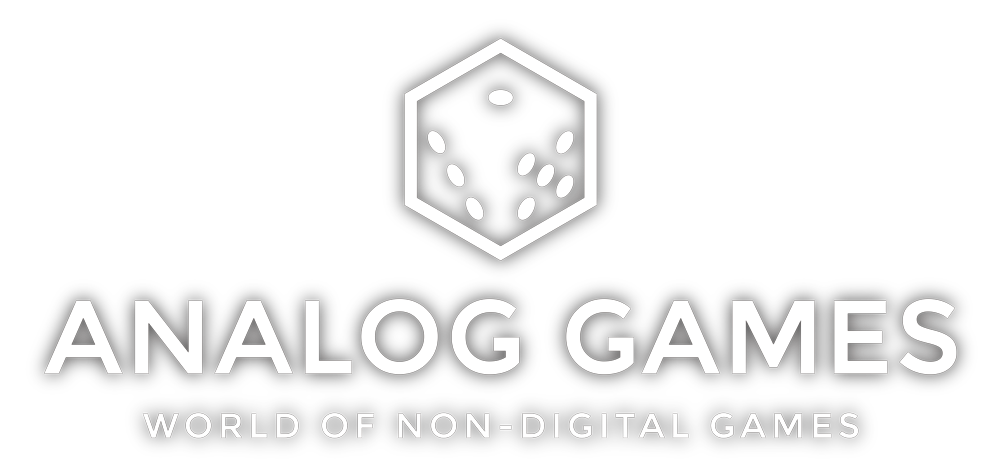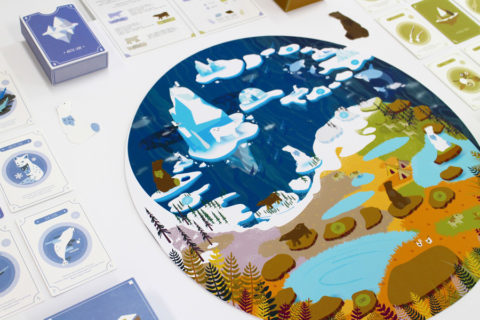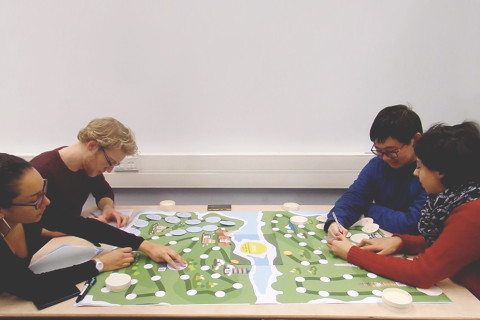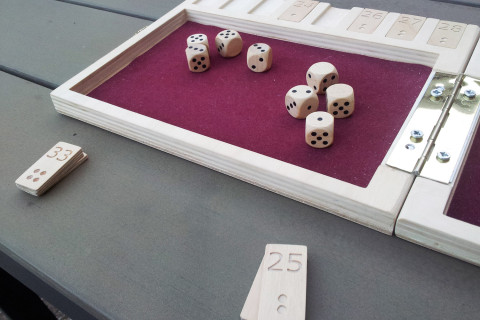I’m Matt Leacock, a board game designer living in Sunnyvale, California. In 2014, I quit my day job to work on board games full time. Before that, I designed games on nights and weekends while working as a user experience designer for a number of Silicon Valley companies. I’m best known for my cooperative games, Pandemic and Forbidden Island, although I enjoy designing all sorts of games.
Game designer Matt Leacock. Photo by Florence Catania.
I’ve been playing and designing games since I was a kid. I played the usual mass market fare (Risk, Monopoly, Uno, and Clue) at my grandmother’s house in Minnesota with my many aunts, uncles, and cousins. I discovered hobby games when I was about 10 or 12. My dad and his brothers grew up playing 3M and Avalon Hill games and they shared them with me. While Tactics, Battle of the Bulge, and Gettysburg didn’t grab me, I loved playing Acquire, Bazaar, and Civilization. My favorite birthday gifts were boardgames, and I started tinkering with design when I’d get a game that I didn’t enjoy – that was the excuse for me to flip over the board, pull out some markers and try to come up with something better.
Artwork from Borderlands by Glen Proctor.
I formed board game clubs in high school and college and continued designing them, finding it a great way to sharpen my skills as a budding graphic designer. My first big projects were a zine for our local Blood Bowl league (called Spike!) and two board games that I’d later self-publish. The first was a card game called Borderlands and the second was a car racing game called Lunatix Loop. Borderlands never went anywhere beyond a few local hobby shops, but I continued to develop Lunatix Loop over the coming years. My best friend, Glen Proctor did the bulk of the artwork for those games and I was often only able to pay him in beer.
Lunatix Loop by Matt Leacock.
In 1997, I left the Midwest for the San Francisco Bay Area to work at Claris as a visual interface designer. Four months later, about half of the company (including myself) was sacked as Steve Jobs restructured Apple. This turned out to be a good thing – it later opened up the possibility that the lovely and talented Donna McKeown, a former colleague, might consider dating me. I typeset her résumé and we started to hang out together as we both looked for new jobs. In 2000, we were married and she’s been my muse and partner-in-crime ever since. To give you a sense of her openness to the hobby – while we were preparing our out-of-state wedding, she was patient enough to help hand-assemble 200 sets of Lunatix Loop that I planned to sell at Spiel, in Essen Germany. I tacked the Essen trip on to our honeymoon: Donna and I cruised the Nile and the Mediterranean; she flew back home and I went on to Germany.
Donna. Photo by Matt Leacock.
I attended Spiel with Rick Heli and Phil Vogt who had a self-published game of their own called Balmy Balloonists. (Back then, self-publishing for us meant running off a lot of copies on a laser printer and stuffing them into labeled, letter-sized packing boxes.) Together, we somehow figured out how to ship our games to Germany, assemble them in our hotel rooms, set up a booth, and start selling in Hall 9 at Messe Essen. We met a lot of people there who would later become friends and business partners. One such introduction was Alan Moon (designer of Elfenland, and later, Ticket-to-Ride). Alan had just cut a country music album (a story for another time) and generously invited us to his Gathering of Friends convention.
Playing Lunatix Loop at Spiel in 2000.
I continued to develop games and brought prototypes to the Gathering of Friends over several years. Two games stood out. One was a game called Ants! (an early worker-placement game where the players manage ant colonies) and another was called Pandemic. Pandemic was inspired by Reiner Knizia’s Lord of the Rings – the first cooperative game that I played that I truly enjoyed. I designed it to play with Donna. I had noticed that we both enjoyed playing cooperative games together (as opposed to competitive – or even worse – negotiation games) and win or lose we always had a good time.
First prototype of the Pandemic board.
I did a lot of playtesting on Pandemic over lunches at Yahoo! and at the Gathering, and In 2007, after about three years of development and countless suggestions by playtesters, it was ready. I shopped it around the floor and it generated a lot of interest. One of those interested was Zev Shlasinger of Z-man Games who agreed to publish it soon after. The rest, as they say, is history.
Dutch version of Pandemic. Photo by Niels Muñoz (@movetherobber).
Pandemic did much better than I’d ever hoped. It now has three expansions (all co-designed with Tom Lehmann), a dice version named Pandemic: The Cure (which has its own upcoming expansion, Experimental Meds, coming this fall), a Cthulhu version, (Pandemic: Reign of Cthulhu, by Chuck Yeager), and its first historical variant, Pandemic Iberia, that I co-designed by Jesús Torres Castro (also coming this fall). In 2015, Rob Daviau and I designed Pandemic Legacy, a game that combines Pandemic with the “legacy” concept that Rob pioneered in his game Risk Legacy. Pandemic Legacy has gone on to top the charts at BoardGameGeek and pick up numerous awards. I have to also credit Sophie Gravel and her team at Z-man/F2Z for all of their amazing work on the Pandemic line.
Role cards of Pandemic. Photo by Niels Muñoz (@movetherobber).
After Pandemic, I designed Roll Through the Ages: The Bronze Age (2009), Forbidden Island (2010) and Forbidden Desert (2013). In 2014, while knee-deep in the design of Thunderbirds: The Cooperative Board Game, its three expansions, and Pandemic Legacy, Donna and I decided that I should make the shift to full time. Juggling the job at the startup company and two large projects was getting to be a bit too much to handle and we were (fortunately) in a position where we could begin to make a living off the games. It was like a dream come true for me.
Forbidden Island (2010). Photo by Niels Muñoz (@movetherobber).
The idea for the Thunderbirds game was pitched to me by Chris Birch of Modiphius at Spiel in 2013. Chris grew up watching the show (a 1960s British action/adventure series for kids that featured models, marionettes, and explosions) and was so enthusiastic about the show and its fit as a cooperative game that I promised him I’d check it out. (I’d never seen the show.) After a few episodes, I was hooked, saw the potential, and started sketching. Over the next year, I’d watched nearly every episode and movie and read every source book. Before long, the Kickstarter campaign for the game was running, and I took the opportunity to work directly with the community of backers by opening up the editing of the live Google Doc of the rules so people could review and make suggestions as I polished the design. The Kickstarter was a great success and we unlocked three expansions and a roleplaying supplement.
Thunderbirds Prototype. Photo by Matt Leacock.
The idea for Pandemic Legacy first came up when I was visiting Z-man in Montréal in 2012. We threw around ideas for a Pandemic dice game (which later became Pandemic: The Cure), a card game, and briefly considered a Pandemic “legacy” game. I shelved the idea at the time; it was too big a project to take on and I didn’t know where to begin. For some reason, in 2013, I sat down with a sketchbook and started drafting out ideas for what such a game would entail. It wasn’t too long before I had pages filled – and knew the game needed to happen. Shortly after, I worked with Z-man to get in touch with Rob. I pitched him the idea in August 2013. He immediately agreed, and we’ve been working together ever since.
Pandemic: The Cure and Pandemic: The Cure – Experimental Meds. Photo by Matt Leacock.
Since my move to full time in 2014, I’ve been working on Pandemic Legacy: Season 2 with Rob; designed and released Knit Wit, a party game where you “knit” words together with witty answers using string; and co-designed Pandemic Iberia and Pandemic: The Cure – Experimental Meds. In the tradition of Roll Through the Ages, I also designed a new dice game called Chariot Race coming this fall that I’m really excited about. And there’s more to come in 2017. I’m grateful to be able to do what I love for a living and look forward to the conventions each year when I get to meet and interact with players and fans.
Photo credits: Matt Leacock /  Niels Muñoz (@movetherobber). Used with permission.
Niels Muñoz (@movetherobber). Used with permission.
Get Forbidden Island, Pandemic
, or Pandemic Legacy
on Amazon.
Did you like this story? Please share or comment. Go to this page to submit a story yourself. Subscribe to our online magazine here!




What a fun read! Thanks for sharing.
I really love Pandemic Legacy. It is a year long commitment to a game, which to me is really special!
Great game designer. Pandemic Legacy has been keeping me on the edge of my seat!
❤ boardgames
The point of view of your article has taught me a lot, and I already know how to improve the paper on gate.oi, thank you. https://www.gate.io/zh/signup/XwNAU
It’s a good thing you gave me, man. I understood your stuff before and you are very good. I actually like what you’ve learned here. I love what you say and the way you say it. You make it fun and still take care to keep it smart. I can’t wait to read more from you. This is actually a great website. 먹튀검증
Your point of view caught my eye and was very interesting. Thanks. I have a question for you. https://www.binance.com/pt-BR/join?ref=UM6SMJM3
Good step you have written of writing content relating to cooperate sense. Better yet good working skills and hope you write more of this soon.Sixty Minutes José Barros Leather Jacket
It’s a game. Five dollars is free. Try it It’s not an easy game
->-> 카지노검증업체 .COM
Thank you very much for sharing, I learned a lot from your article. Very cool. Thanks.
Your point of view caught my eye and was very interesting. Thanks. I have a question for you.
Your article helped me a lot, is there any more related content? Thanks!
Your article helped me a lot, is there any more related content? Thanks!